Menus
- Radically rebuilt classic
- ERLA-Norton in MOTORRAD 8/1977
- "To Erich, toast coffee."
- Technical data ERLA-Norton Commando
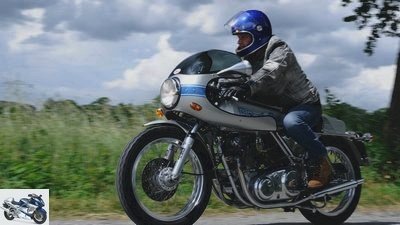
Fred Siemer
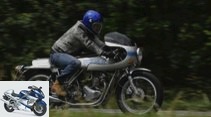
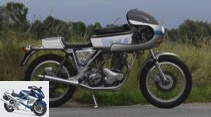
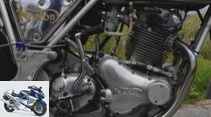
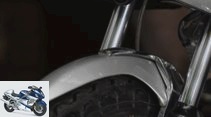
16 photos
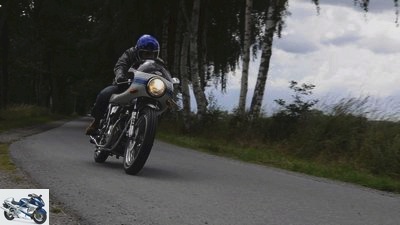
Fred Siemer
1/16
Picture gallery: ERLA-Norton Commando.
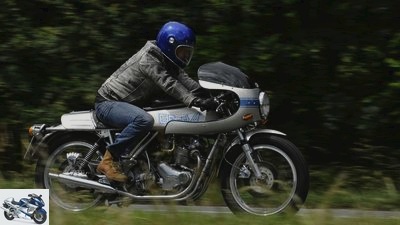
Fred Siemer
2/16
Erich Lawrenz knew what to do with Isolastic: paralyze it, so to speak.
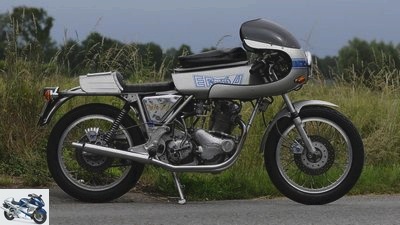
Fred Siemer
3/16
ERLA-Norton Commando.
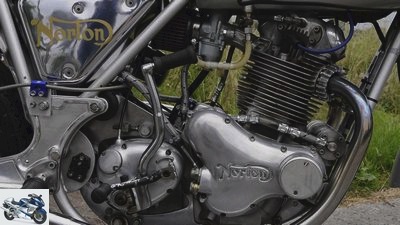
Fred Siemer
4/16
In front of the footrest, you can clearly see the mount for the swing arm mounting added by Erich Lawrenz.
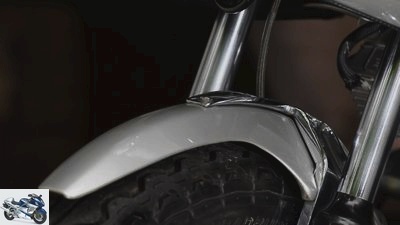
Fred Siemer
5/16
Form and function: The pretty mudguard holder also serves as a fork stabilizer.

Fred Siemer
6/16
Friendship service: Polsterer Luchtenborg made Rheda look like new.
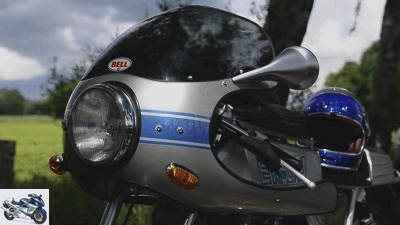
Fred Siemer
7/16
In contrast to Norton himself, Erich Lawrenz found that a speedy motorcycle can still wear disguise. A Ducai 750 SS anyway. Because unlike Norton, the race-proven Westphalian had planned long full throttle stages.
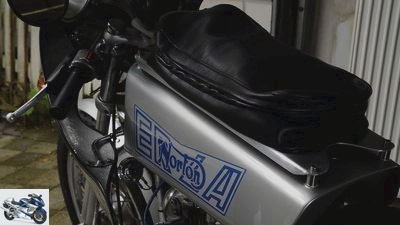
Fred Siemer
8/16
Even with the tank bag, Erich Lawrenz did not want to allow any wobble and prescribed a fixed base plate.
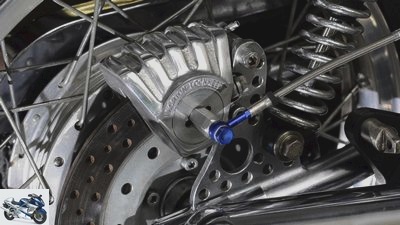
Fred Siemer
9/16
The self-made swing arm naturally also offers the mount for a contemporary disc brake.
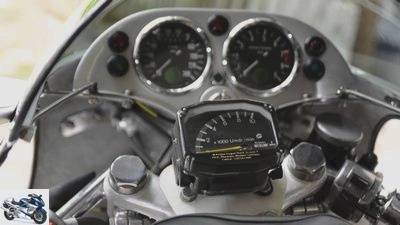
Fred Siemer
10/16
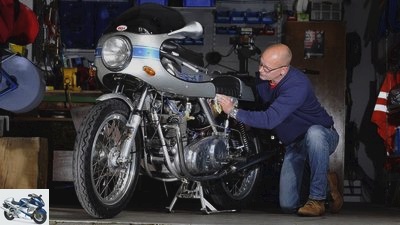
Fred Siemer
11/16
ERLA-Norton Commando.
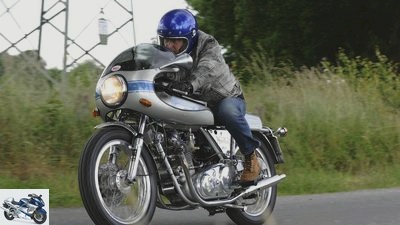
Fred Siemer
12/16
On the very first exit, the electrics went dead.
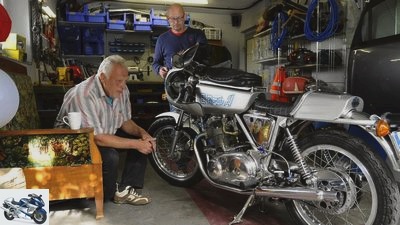
Fred Siemer
13/16
Karl-Heinz Rappold (left) and Ralf Lietz are happy that the 40-year-old ERLA shines like new again.
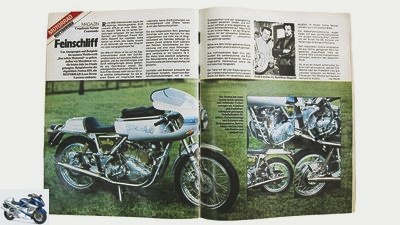
Fred Siemer
14/16
In 1977 Karl-Heinz could be seen in MOTORRAD together with the builder Lawrenz, who died in 1997 (small photo, left). Back then it was drastic
improved Norton Commando as a technical sensation.
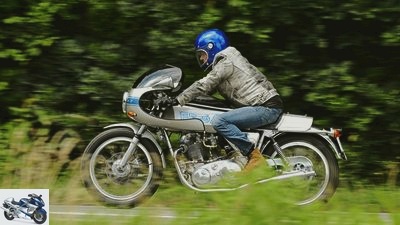
Fred Siemer
15/16
ERLA-Norton Commando.
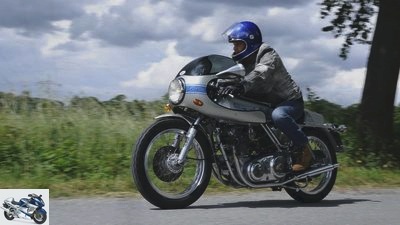
Fred Siemer
16/16
Picture gallery: ERLA-Norton Commando.
ERLA-Norton Commando
Radically rebuilt classic
Content of
40 years ago, its builder had his own technical views, and the last owner had quite specific ideas about how to use it. And the current one persistently ran after this radically rebuilt Norton. Westphalia, all three.
Entire generations of sporty drivers viewed the wide, curved Norton feather bed frame as the measure of all things. And then of all things NOrton retired him. The reason? The desire for ever higher performance forced the British to ever larger displacements, and while their co-rotating twin in the 600 Dominator still behaved quite well, the 750 Atlas proved to be a real shaker. Its successor, the Commando presented in 1967, should be less annoying to its crew, and that’s why the engine, gearbox and rocker arm were attached to two large plates and everything was stored in lush, vibration-absorbing rubber elements within the completely newly developed main frame. It consisted of a sturdy top tube and two loops that were again wide and clever struts. Very stable, the whole thing, but only if the rubber elements were properly spaced and did not have an inadmissibly high clearance for their recordings. In that case, the construction called Isolastic frame knew quite a few pitfalls.
Buy complete article
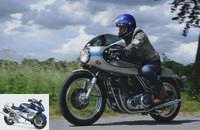
ERLA-Norton Commando
Radically rebuilt classic
At that time brand new Norton Commando 850
Of course, all of this had got around in this country and as far as Herzfeld in Westphalia, and that’s why the gifted inventor Erich Lawrenz knew what to do with Isolastic when he bought a brand new Commando 850 in the mid-1970s. Paralyzing, so to speak, because the technician, who was socialized as a driver in rail sports and highly valued as a designer, again gave the main frame proper shots in which he could thread the newly made, quadruple ball-bearing axle of a swing arm he had designed. Put an end to the rather narrow storage in the retaining plates on the gearbox. Nevertheless, the engine was allowed to fidget in rubber, now – if you will – with the pivot axis as the pivot.
But this long-term stabilizing measure was not enough for Lawrenz: On the way to the dream motorcycle, the Commando got the half-shell of a Ducati 750 SS, befitting high-shoulder rims from Borrani, new wheel hubs, rear disc brakes instead of drum brakes, machined and perforated brake discs, one made by itself from seamless tube Exhaust system. Take a short breath, then continue in the program: Because – unlike many other British drivers – he wanted to really gas on the autobahn, Lawrenz donated valve guides made of low-friction Caro bronze, installed a specially turned oil cooler and built for the 4.5 Liter of oil supply a new tank that also offers space for the battery. Chain guard, footrests, handlebar stubs, bench with integrated tool compartment and kick starter? Everything self-made. And of course Erich Lawrenz even created the crazy 20-liter tank with his own hands. The man obviously thought that Harro had stopped halfway with the elephant boy and screwed a sheet metal plate onto the flattened top of the fuel barrel along with – of course – a tank bag he had designed himself.
ERLA-Norton in MOTORRAD 8/1977
When everything was ready, Lawrenz had had enough. He sold to Karl-Heinz Rappold, a good friend from nearby Lipperode near Lippstadt, who in turn was so enthusiastic about his new acquisition that he entered it under Lawrenz’s name in the MOTORRAD competition “Readers build the greatest motorcycle”. After a detailed examination of this proposal, reporter Ilse Reuter and photographer Uli Schwab moved out to Lipperode, in issue 8/1977 they presented the ERLA-Norton. A certain Manfred Rau with his lattice tube-framed Laverda treble hook won the reader competition, but Karl-Heinz Rappold still remained an ERLA fan. Hurried through his military service with the 850, attended races, went back to work, earned good money – and bought a new one in 1979. Because he really loves motorcycles, the fast ERLA-Norton was allowed to stay. There was space, namely in the window of his mother’s former grocery store.
There again, which can hardly be avoided in a well-structured community like Lipperode, Ralf Lietz kept dropping by. On the way to shopping, to training, to work. A late-career motorcycle enthusiast, but still a madman. At the beginning of his passion, NSU Quickly restorations were enough for him, and they also matched his driver’s license. Then a DKW RT 175 snowed into the house, and when it was really pretty in 2012, the one had to be produced. After that, the now 50-year-old converted a BMW R 45 in a stylish manner and refurbished a 125 MV. The Italian came from said Rappold, and her revival, said Lietz, should finally move this stubborn dog to give him the long-awaited ERLA. But didn’t. Oh, Westphalia can be so slow …
But in the end it was friendly, because in view of the abundance in his shop window, Karl-Heinz Rappold finally admitted that he had enough other motorcycles to get afloat for the rest of his life. With the promise to involve the Kreidler specialists, who are known far beyond Lippstadt, from time to time in the restoration, Ralf Lietz was finally able to pick up the Norton in October 2015.
"To Erich, toast coffee."
The engine, Rappold announced convincingly, ran properly until the end. So it wasn’t opened before. On the other hand, it quickly became clear that the ERLA had not enjoyed an orderly shutdown and conservation: The corroded Amal carburettors were completely replaced, the brake cylinders were really tight. Reseal, then new lines – that was the biggest technical work. Thought Lietz when he drove up to the TÜV on December 22nd. Zero problems, which, by the way, is no wonder in view of the extremely well thought-out and meticulous work of Erich Lawrenz. If you don’t trust this motorcycle, you should walk.
Ralf Lietz soon had to do that, because an ERLA is only as strong as its weakest part. On Christmas Eve – one day after the re-registration – the technical officer wanted to give himself the gift of the first exit. But the 40-year-old electrical system couldn’t withstand the startling traffic, and that’s why Lietz didn’t twiddle his thumbs after work in January, as planned, but rather a new wiring harness.
Since spring, the two have been experiencing an increasingly fruitful phase of getting to know each other, and it does not seem to be ruled out that next year it will be checked whether Erich Lawrenz’s work has really led to stable driving behavior even at high speed. Just like Karl-Heinz Rappold conjures up when he cycles over for a coffee and enjoys the new, old shine of the ERLA. His buddy Erich later put two conversions on the wheels, a Yamaha XS 650 that was brought to almost 900 cm³ and the chassis was drastically improved, as well as an NSU Konsul-based single-cylinder in a feather bed (!) Frame. They recently received some attention not in this, but in another journal. “Rightly”, says Ralf Lietz, “but here is the first ERLA.” Karl-Heinz Rappold grins over. “To Erich, cheers for coffee.”
Technical data ERLA-Norton Commando
Engine: Air-cooled two-cylinder four-stroke engine, two valves hanging in the head per combustion chamber, actuated via an underlying camshaft, bumpers and rocker arms, two Amal carburettors with K + N air filters, self-made two-in-two exhaust system, dry sump lubrication, 828 cm³, 51 hp at 6,250 rpm
Drive: Primary drive via triple chain, multi-plate dry clutch with disc spring, four-speed gearbox, secondary drive via chain
Landing gear: Double loop frame made of tubular steel, subsequently welded-in swing arm mounts, front standard telescopic fork with self-made fork stabilizer, rear self-made swing arm, front tires 3.25 x 19, rear 3.50 x 19 on Borani high-shoulder rims, Lockheed disc brakes front and rear, wheelbase 1,440 mm, dry weight approx. 180 kg
Related articles
-
Cult bike Norton Commando 750 Roadster
Wait Cult bike Norton Commando 750 Roadster 1967 a real superbike Norton rose to its former size one last time and in 1967 created the Norton Commando…
-
Impression Norton Commando 750 Roadster
Impression Norton Commando 750 Roadster Superbike for a summer In a brief moment of non-simultaneity, the slim and excitingly styled Norton Commando was…
-
On the move with Ducati 860 GTS and Norton Commando 850
fact 32 photos fact 1/32 Ducati 860 GTS and Norton Commando 850 on the move. fact 2/32 Ducati 860 GTS and Norton Commando 850 on the move. archive 3/32…
-
Norton Commando 961 Sport MK II (2018) in the test
Arturo Rivas 11 pictures Arturo Rivas 1/11 How well does the Norton Commando 961 Sport MK II from model year 2018 perform in the test? Arturo Rivas 2/11 More …
-
Norton Commando 850, Norton Commando 961 Sport
Cathcart The comparison with the original Norton Commando 850, Norton Commando 961 Sport content of The newly launched Norton Commando 961 …
-
Norton Commando 961 from 2012 – Technical data
Norton Commando 961 Technical Specifications from 2012 Technical specifications engine Number of cylinders, type 2, in-line engine power 64.7 kW / 88.0…
-
Norton Commando 961 Sport Breitling special model
Norton 5 pictures Norton 1/5 The British motorcycle manufacturer, in cooperation with the watch manufacturer Breitling, has created the special Norton Breitling …
-
Siemer 25 pictures Siemer 1/25 Siemer 2/25 Siemer 3/25 Bernd Lienstadt doesn’t need any show talent as a two-wheeled companion. An honest skin is to him …
-
On the move with the Muller-Yamaha XS 400T
Fred Siemer 16 photos Fred Siemer 1/16 Yamaha XS 400T Fred Siemer 2/16 Yamaha XS 400T. Fred Siemer 3/16 Yamaha XS 400T. Fred Siemer 4/16 The compact twin…
-
Norton Command 961 driving report
Cathcart 8 pictures Norton 1/8 Norton Commando 961 SE Norton 2/8 Norton Commando 961: The Cafe Racer (13495 pounds) is adorned with a sports exhaust. Norton 3/8 …